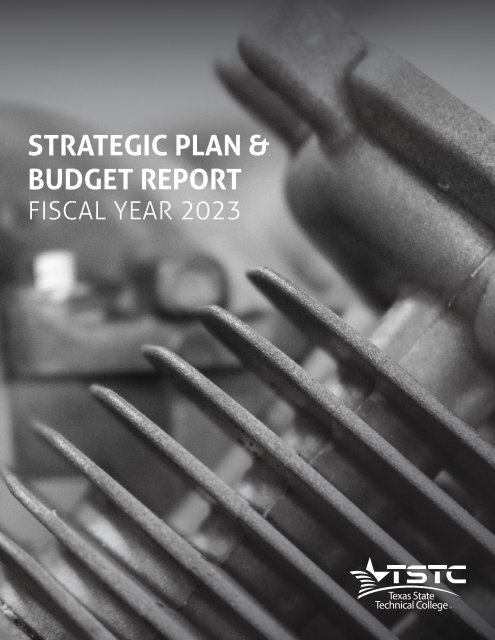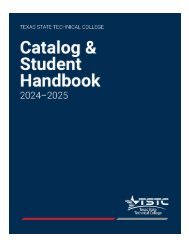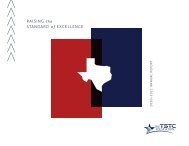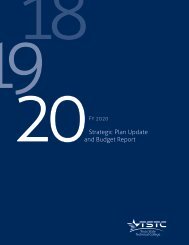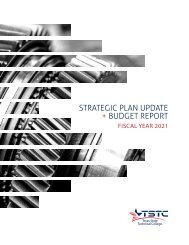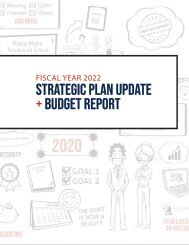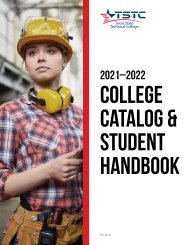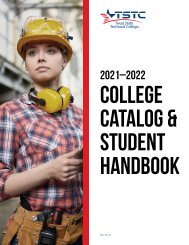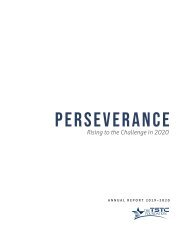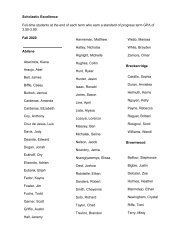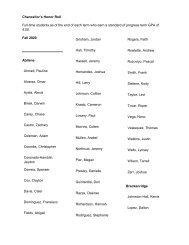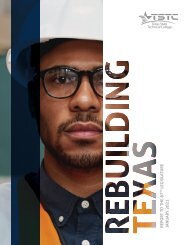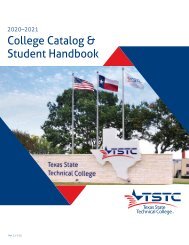You also want an ePaper? Increase the reach of your titles
YUMPU automatically turns print PDFs into web optimized ePapers that Google loves.
STRATEGIC PLAN &<br />
BUDGET REPORT<br />
FISCAL YEAR 2023
APPROVED 08/18/2022
APPROVED 08/18/2022<br />
A LETTER FROM THE CFO<br />
To our Regents,<br />
“Be bold? Or be safe?” These were the options considered<br />
by TSTC’s leadership team as it weighed the College’s<br />
commitments for the next five years. Our varying instincts<br />
forced us to wrestle with our response. Fortunately, we’ve<br />
spent much time in recent years (including periodic<br />
sessions with you) contemplating this moment.<br />
A year ago, we reflected on the history of this<br />
administration, considered the p<strong>and</strong>emic impact <strong>and</strong><br />
imagined our place in a post-COVID world. Since then,<br />
we’ve researched changing expectations, assessed rapidly<br />
emerging opportunities, <strong>and</strong> evaluated the strengths of<br />
ourselves <strong>and</strong> our competitors.<br />
With major disruptions, such as those ushered in by the<br />
p<strong>and</strong>emic, opportunists <strong>and</strong> market leaders respond in a<br />
way that accelerates them into a new future. TSTC did not<br />
miss out on that opportunity. We seized the moment <strong>and</strong> innovated towards a new normal.<br />
It is clear to the team. TSTC’s opportunity to grow as a market leader is right in front of us. This window of<br />
opportunity will not remain open forever. This growth will not merely be the result of choosing a path. This<br />
success will only be realized as a result of bold commitment, disciplined execution, <strong>and</strong> accountability to<br />
higher levels of growth <strong>and</strong> change.<br />
So, what’s the answer to our question? It’s unanimous. We must be bold. TSTC will bet on itself. We will<br />
execute at a level we’ve never seen before. Texans, especially students <strong>and</strong> industry, will see us as a different<br />
kind of institution, in compelling ways. We will be better than the rest, accountable to Texas industry as its<br />
premier workforce provider.<br />
The leadership team looks forward to sharing our plans <strong>and</strong> the related budget proposal as we<br />
accelerate into our future together.<br />
With enthusiasm,<br />
Jonathan Hoekstra, CPA, MBA, Vice Chancellor & Chief Financial Officer<br />
STRATEGIC PLAN & BUDGET REPORT<br />
3
APPROVED 08/18/2022<br />
TABLE OF<br />
CONTENTS<br />
A LETTER FROM THE CFO 03<br />
SUSTAINING OUR COMPETITIVE ADVANTAGE 05<br />
THE PLAN 06<br />
NECESSARY TRANSFORMATIONS 09<br />
OPERATING BUDGET 17<br />
CAPITAL BUDGET & CCAP 25<br />
EXHIBITS<br />
SITUATIONAL CONTEXT 30<br />
HISTORICAL OVERVIEW 32<br />
CONNECTING THE DOTS 33<br />
WIG TRENDS 34<br />
DETAILED OPERATING EXPENSE BUDGET 36<br />
TSTC DEFINITIONS 41<br />
ACKNOWLEDGMENTS 42
APPROVED 08/18/2022<br />
SUSTAINING<br />
OUR<br />
COMPETITIVE<br />
ADVANTAGE<br />
TSTC operates in a competitive<br />
ecosystem that joins two<br />
marketplaces: the consumer<br />
market of underskilled job seekers<br />
(prospective students) <strong>and</strong> a labor<br />
market of employers seeking a<br />
competitive workforce to fuel<br />
their enterprise. Where those<br />
two markets meet, competition<br />
in the higher education industry<br />
grows more fierce with new<br />
competitors, new market leaders,<br />
new disruptive technologies, <strong>and</strong><br />
new approaches to education.<br />
To thrive in highly competitive<br />
environments firms must deliver<br />
their products, services, br<strong>and</strong>, <strong>and</strong><br />
reputation in a way that attracts<br />
markets continually over time.<br />
That is, to win in a competitive<br />
marketplace, one must build<br />
a sustainable competitive<br />
advantage.<br />
In pursuit of building such an<br />
advantage, TSTC leadership has<br />
reflected on the past, current,<br />
<strong>and</strong> future state of industry<br />
dem<strong>and</strong>, competition <strong>and</strong><br />
other environmental factors.<br />
Leadership captured this<br />
assessment in the framework<br />
of strengths, weaknesses,<br />
opportunities, <strong>and</strong> threats<br />
(SWOT Analysis) through the<br />
lens of TSTC, its competition,<br />
<strong>and</strong> the marketplace of<br />
employers <strong>and</strong> consumers.<br />
This SWOT Analysis included<br />
the identification of critical<br />
pairings to highlight unique<br />
value propositions <strong>and</strong><br />
market opportunities. An<br />
example of this is outlined in<br />
Figure 01.<br />
Critical pairings answer<br />
questions like “Where<br />
can TSTC focus that the<br />
competition cannot?” After<br />
months of refining <strong>and</strong><br />
recasting past, present <strong>and</strong><br />
future state assumptions,<br />
TSTC leadership identified<br />
three focus areas that<br />
define TSTC’s position in the<br />
competitive marketplace.<br />
They are called the Big 3,<br />
TSTC’s <strong>Strategic</strong> Imperatives,<br />
<strong>and</strong> they will define the<br />
sustainable competitive<br />
advantage.<br />
Figure 01<br />
Environmental<br />
Opportunity<br />
(skills gap)<br />
TSTC Strength<br />
(high-tech,<br />
high-dem<strong>and</strong><br />
programs)<br />
Critical Pairing<br />
Figure 02<br />
Be Better than Others<br />
We believe that providing<br />
quality in all we do<br />
increases stakeholder<br />
satisfaction.<br />
STRATEGIC PLAN & BUDGET REPORT<br />
5
APPROVED 08/18/2022<br />
THE PLAN<br />
TSTC leadership routinely reviews <strong>and</strong> reaffirms<br />
the mission of the College as prescribed in<br />
Chapter 135 of the Texas Education Code. It is<br />
summed up in the rallying cry to Place More<br />
Texans in Great Paying Jobs (PMTIGPJ) <strong>and</strong> two<br />
Wildly Important Goals (WIGs) describe the<br />
targeted outcomes expected.<br />
WIG 1:<br />
Quantity of Former Students<br />
Found Working<br />
The first Wildly Important Goal is a<br />
measure of production quantity evidenced by<br />
growth expectations around the number of<br />
former students found working. Former Students<br />
includes students that leave college with no<br />
credentials <strong>and</strong> graduates or award recipients.<br />
Consistent with TSTC’s mission <strong>and</strong> plans to<br />
position the College with the features of the Big<br />
3, the long-range planning includes (1) growth<br />
in the production of workforce (measured<br />
by former students found working) <strong>and</strong> (2)<br />
transformational initiatives necessary for<br />
needed growth.<br />
Figure 03<br />
Actuals<br />
Forecast<br />
WIG 1 Goal<br />
3-YEAR GOAL<br />
TSTC will increase the number of<br />
students found working from 3,454 in<br />
2020 to 3,824 in 2023.<br />
5-YEAR GOAL<br />
TSTC will increase the number of<br />
students found working from 3,454 in<br />
2020 to 4,001 in 2025.<br />
Students Found Working - Quantity<br />
4,600 4,607<br />
13 programs<br />
underperformed <strong>and</strong><br />
were closed.<br />
4,057<br />
4,132<br />
Resources were<br />
reinvested into high<br />
dem<strong>and</strong> technical<br />
programs.<br />
4,001<br />
3,824<br />
3,824<br />
3,893<br />
3,650<br />
3,454<br />
2016 2017 2018 2019 2020 2021 2022 2023 2024 2025<br />
6<br />
STRATEGIC PLAN & BUDGET REPORT
APPROVED 08/18/2022<br />
WIG 2:<br />
Quality of Former<br />
Students Wages<br />
The second Wildly Important Goal is a measure<br />
of production quality evidenced by the earnings<br />
strength of former students, an indication of<br />
the quality that industry is willing to pay for<br />
the skills they are acquiring. Like WIG 1, Former<br />
Students includes students that leave college<br />
with no credentials, <strong>and</strong> graduates or award<br />
recipients. TSTC is accountable for every student<br />
that attends at least 9 semester credit hours.<br />
Therefore the plans include the wages of leavers<br />
<strong>and</strong> graduates combined in goal setting.<br />
3-YEAR GOAL<br />
5-YEAR GOAL<br />
Figure 04<br />
Average First Year Wages - Quality<br />
Actuals<br />
Forecast<br />
WIG 2 Goal<br />
13 programs<br />
underperformed<br />
<strong>and</strong> were closed.<br />
49,485<br />
52,344<br />
Resources were<br />
reinvested into high<br />
dem<strong>and</strong> technical<br />
programs.<br />
42,237<br />
46,134<br />
36,655<br />
33,300<br />
33,763 33,466<br />
31,243<br />
28,910<br />
2016 2017 2018 2019 2020 2021 2022 2023 2024 2025<br />
STRATEGIC PLAN & BUDGET REPORT<br />
7
APPROVED 08/18/2022<br />
EXCELLENCE<br />
Holding oneself to the highest st<strong>and</strong>ards of<br />
quality, workplace performance <strong>and</strong> behavior.<br />
8<br />
STRATEGIC PLAN & BUDGET REPORT
APPROVED 08/18/2022<br />
NECESSARY<br />
TRANSFORMATIONS<br />
STRATEGIC PLAN & BUDGET REPORT<br />
9
APPROVED 08/18/2022<br />
BUILD<br />
INTEGRATED<br />
MARKETING<br />
The higher education industry l<strong>and</strong>scape is more<br />
competitive than ever <strong>and</strong> dem<strong>and</strong> for a skilled<br />
workforce has never been greater. Because<br />
the ultimate goal is to respond to the needs of<br />
industry, the scope of the integrated marketing<br />
initiative is not limited to the consumer market.<br />
It must include an underst<strong>and</strong>ing of industry’s<br />
needs.<br />
The transformation of TSTC’s marketing<br />
capabilities is paramount to TSTC’s growth <strong>and</strong><br />
future. In fact, it is necessary in order to increase<br />
enrollment, graduation rates <strong>and</strong> placement in<br />
the Texas workforce. The evolution will permeate<br />
across the enterprise <strong>and</strong> state, increase br<strong>and</strong><br />
awareness, communicate the student <strong>and</strong><br />
economic value proposition, <strong>and</strong> scale TSTC’s<br />
ability to create <strong>and</strong> convert on both consumer<br />
<strong>and</strong> industry dem<strong>and</strong>.<br />
In fiscal year 2022, TSTC contracted both a<br />
fractional chief marketing officer <strong>and</strong> a market<br />
research firm. The multi-year build of integrated<br />
marketing is currently underway <strong>and</strong> includes<br />
assessing TSTC’s needs, modernizing <strong>and</strong><br />
focusing promotional efforts, <strong>and</strong> deepening the<br />
underst<strong>and</strong>ing of TSTC’s customers.<br />
10<br />
STRATEGIC PLAN & BUDGET REPORT
APPROVED 08/18/2022<br />
RETOOL THE<br />
PRODUCTION<br />
FLOOR<br />
Retooling the production floor simply means<br />
reimagining the way students train at TSTC,<br />
from pathways <strong>and</strong> micro credentials, to new<br />
modalities <strong>and</strong> opportunities that meet the<br />
needs of today’s students. Traditional college<br />
models focus on credit hours <strong>and</strong> grades,<br />
while performance-based education replaces<br />
that old notion with demonstrated mastery of<br />
essential knowledge <strong>and</strong> skills. Performancebased<br />
education emphasizes value, flexibility,<br />
convenience <strong>and</strong> applied learning that involves<br />
frequent, substantive interaction between an<br />
apprentice <strong>and</strong> an expert.<br />
To scale this learning experience, TSTC<br />
implemented shared service capabilities to<br />
deconstruct every course’s learning objectives<br />
into skills <strong>and</strong> competencies. Each skill <strong>and</strong><br />
competency is then calibrated with subject<br />
matter experts to ensure training always aligns<br />
with industry’s needs.<br />
TSTC designed this new way of learning to<br />
serve untapped markets that traditional<br />
education struggles to reach. It is relevant to<br />
non-traditional student markets such as working<br />
adults, family caregivers, military veterans,<br />
<strong>and</strong> college skeptics who seek relevance in<br />
their time-on-task <strong>and</strong> value the shift from<br />
transactional education to performance-based<br />
education.<br />
In fiscal year 2022, TSTC launched the first<br />
phase of a 3-phase implementation of<br />
performance-based education across all<br />
programs. This includes the reconfiguration of<br />
curriculum, labs, learning delivery, schedules,<br />
<strong>and</strong> faculty talent requirements. The remaining<br />
phases will launch over the next three years<br />
with sustainability efforts to follow.<br />
STRATEGIC PLAN & BUDGET REPORT<br />
11
APPROVED 08/18/2022<br />
EXECUTE ON CAPITAL<br />
CONSTRUCTION<br />
ASSISTANCE<br />
PROJECTS<br />
During the third special session of the 87th<br />
legislative session, the Texas Legislature<br />
increased its commitment to workforce<br />
training capacity when it authorized $208<br />
million in bond authority (capital construction<br />
assistance projects or CCAP) for construction<br />
of technical education facilities. Largely due to<br />
unprecedented increases in construction prices<br />
in the two years following the initial request,<br />
TSTC determined up to an additional $187<br />
million of institutional (non-CCAP) proceeds are<br />
necessary to deliver on its original promise to<br />
increase training capacity<br />
The CCAP projects are currently budgeted to<br />
include $358.5 million of new construction<br />
<strong>and</strong> real estate expansion, <strong>and</strong> $15 million<br />
in renovations across seven campuses. With<br />
statewide construction capacity spread thin<br />
across enormous construction dem<strong>and</strong>s in the<br />
industry, managing the construction efforts of<br />
contractors requires higher levels of scrutiny to<br />
ensure quality delivery of TSTC’s projects. The<br />
margin of error is small, requiring high levels<br />
of project management, collaboration across<br />
various affected disciplines, <strong>and</strong> fiscal oversight<br />
of these high-value contracts.<br />
Project delivery will occur over the next four<br />
years, affecting the facilities capacity required to<br />
meet sales goals.<br />
TSTC will shift from project pre-design in fiscal<br />
year 2022 to final design <strong>and</strong> construction for<br />
most projects in fiscal year 2023. Bond sales<br />
are planned for Fall 2023. Facilities are planned<br />
to come online between Fall 2024 <strong>and</strong> Spring<br />
2026.<br />
12<br />
STRATEGIC PLAN & BUDGET REPORT
APPROVED 08/18/2022<br />
RE-ENGINEER<br />
PROCESS &<br />
TECHNOLOGY<br />
INFRASTRUCTURE<br />
The processes <strong>and</strong> technologies that have<br />
supported TSTC’s business operations for over<br />
three decades were developed in a bygone<br />
era of technology. To remain relevant in the<br />
disruptive, exponentially-changing era of today,<br />
the College had to re-imagine <strong>and</strong> re-engineer<br />
virtually all of its business processes. Following<br />
the Board’s approval, TSTC began a multi-year,<br />
multi-phase project to transform the digital<br />
experience of TSTC’s constituents. The first<br />
phase included the overhaul of TSTC’s financial<br />
<strong>and</strong> human capital process infrastructure<br />
(Platform). The second phase includes student<br />
lifecycle process infrastructure (Student).<br />
The two phases require team members across<br />
the enterprise to transform processes, crossfunctional<br />
h<strong>and</strong>offs, <strong>and</strong> user interfaces<br />
<strong>and</strong> experiences. These transformations are<br />
necessary to enable the data <strong>and</strong> analytics<br />
needed to accelerate into TSTC’s future.<br />
On April 1, 2022, after over two years of<br />
planning, architecture, configuration, <strong>and</strong><br />
testing, TSTC became the first college or<br />
university in Texas (despite attempts by others)<br />
to implement Platform with the state-of-the-art<br />
technology vendor, Workday. Weeks later, the<br />
College initiated the Student phase.<br />
Enterprise focus will continue surrounding<br />
sustainability <strong>and</strong> version management of<br />
Platform in its post-implementation state. For<br />
Student, the cross-functional implementation<br />
team will plan <strong>and</strong> implement during fiscal<br />
year 2023 <strong>and</strong> 2024 <strong>and</strong> deploy applications<br />
intermittently during the course of the project.<br />
STRATEGIC PLAN & BUDGET REPORT<br />
13
APPROVED 08/18/2022<br />
CULTIVATE A<br />
PERFORMANCE-<br />
BASED CULTURE<br />
As it arose from the merger, TSTC prioritized<br />
culture as wildly important within its first<br />
statewide strategic plan. The results over this<br />
time (2015-2022) were extraordinary. TSTC can<br />
claim a highly engaged workforce <strong>and</strong> a broad<br />
perception by members of the TSTC family that it<br />
is a great place to work.<br />
A performance culture is emerging. TSTC will<br />
build on this area of strength in pursuit of a<br />
culture that will drive TSTC’s differentiation<br />
in the marketplace. TSTC seeks to shape the<br />
collective attitudes <strong>and</strong> behaviors in such a way<br />
that performance improvement permeates the<br />
fabric of the TSTC culture.<br />
The impact of this pursuit will be characterized<br />
by processes that center around transparency<br />
<strong>and</strong> accountability; by individuals rewarded<br />
(in an inclusive way) for sharing, cooperating<br />
<strong>and</strong> supporting the mission of the College, <strong>and</strong><br />
by the College thinking, strategizing, planning,<br />
analyzing <strong>and</strong> executing as a single unit.<br />
This cultural transformation will be assessed by<br />
evaluating performance capabilities that drive<br />
an entrepreneurial culture. This assessment<br />
includes validated maturity (measured across<br />
models to assess the evolutionary path)<br />
throughout the enterprise in capabilities such as<br />
performance assessment <strong>and</strong> management, data<br />
<strong>and</strong> analytics literacy, coaching, differentiation<br />
<strong>and</strong> scope discipline.<br />
14<br />
STRATEGIC PLAN & BUDGET REPORT
APPROVED 08/18/2022<br />
FORTIFY<br />
APPROPRIATION<br />
FUNDING SOURCES<br />
TSTC’s plans are built primarily on the cause<br />
<strong>and</strong> effect relationship of performance-based<br />
funding. However, those plans are at risk<br />
due to uncertainty in the reliability of TSTC’s<br />
appropriated commission rate (the funding of<br />
TSTC’s returned-value, performance-based,<br />
formula). Variables contributing to uncertainty<br />
include expansion <strong>and</strong> contraction of the overall<br />
state budget, <strong>and</strong> political pressure to prioritize<br />
other initiatives over TSTC’s returned-value<br />
formula, breaking the link between performance<br />
<strong>and</strong> funding.<br />
These are likely risks that increase if those<br />
with influence are uninformed about TSTC’s<br />
plans <strong>and</strong> contributions. People don’t value<br />
what they don’t underst<strong>and</strong>. So TSTC will build<br />
on campaign momentum to constantly create<br />
awareness about (1) the linkage of Texas<br />
prosperity to its ability to fill the skills gaps; (2)<br />
TSTC’s mission to fill those most lucrative gaps;<br />
(3) TSTC’s mission-discipline, execution, <strong>and</strong><br />
the resulting impact on the state; <strong>and</strong> (4) the<br />
constraints preventing even more production<br />
from TSTC.<br />
Fortified appropriations would include<br />
consistent funding of TSTC’s returned-value<br />
formula at the 36% commission rate. The full<br />
impact is not certain since the wages of former<br />
students to be counted in future biennia have<br />
yet to be earned or reported. TSTC estimates<br />
the returned-value appropriation could<br />
potentially increase (over current levels) $25<br />
million <strong>and</strong> $84 million in the 88th <strong>and</strong> 89th<br />
legislative sessions, respectively.<br />
Other funding fortifying moves include<br />
correcting facilities capital funding disparities<br />
<strong>and</strong> facilities capital appropriation requests to<br />
respond to specific market needs.<br />
STRATEGIC PLAN & BUDGET REPORT<br />
15
APPROVED 08/18/2022<br />
ACCOUNTABILITY<br />
Doing what needs to be done <strong>and</strong> being transparent<br />
about the resulting successes <strong>and</strong> failures.
APPROVED 08/18/2022<br />
OPERATING BUDGET<br />
ORGANIZATIONAL<br />
STRUCTURE<br />
& BUDGET<br />
FRAMEWORK<br />
TSTC’s organizational <strong>and</strong> leadership structures<br />
remain consistent for fiscal year 2023, with no<br />
major changes in organizational structure or<br />
operating division hierarchy from the prior year.<br />
The overall allocation of resources across the<br />
functional divisions of the College is illustrated<br />
below.<br />
PRESENTATIONS,<br />
ASSUMPTIONS &<br />
ESTIMATES<br />
Various line items in prior year budget <strong>and</strong><br />
actual amounts have been reclassified<br />
to align with the current organizational<br />
structure <strong>and</strong> budget framework for<br />
consistency in comparative analysis.<br />
Fiscal year 2022 forecast amounts <strong>and</strong><br />
certain fiscal year 2023 budget amounts use<br />
available data <strong>and</strong> related estimates as of<br />
May 31, 2022.<br />
The College will realize appropriation<br />
revenues in fiscal year 2023 in accordance<br />
with bill patterns established by the 87th<br />
Legislature.<br />
Figure 05<br />
2023 BUDGET<br />
$258,398,719<br />
TSTC prepares budgets using a cash basis of<br />
accounting, which includes budgeting tuition<br />
revenue net of discounts <strong>and</strong> allowances,<br />
budgeting debt service payments (total<br />
principal <strong>and</strong> interest) as an expense,<br />
excluding interest expense <strong>and</strong> depreciation<br />
expense, <strong>and</strong> also excluding non-cash<br />
accounting adjustments such as pension<br />
<strong>and</strong> other post-employment benefits (OPEB)<br />
accruals.<br />
MEASURE<br />
PLAN<br />
EXECUTE<br />
BUDGET<br />
The annual budget report is simply a starting<br />
point each year. TSTC anticipates many<br />
refinements to this budget throughout the<br />
year as the needs <strong>and</strong> circumstances of TSTC<br />
departments continually change.<br />
Instruction<br />
Student Financial Aid<br />
Student Services<br />
Facilities & <strong>Plan</strong>t<br />
Statewide Administration<br />
Finance<br />
External Relations<br />
Shared Resources<br />
Statewide Benefits<br />
25.09%<br />
15.73%<br />
12.45%<br />
7.56%<br />
2.28%<br />
4.64%<br />
6.06%<br />
14.14%<br />
12.05%<br />
STRATEGIC PLAN & BUDGET REPORT<br />
17
APPROVED 08/18/2022<br />
FISCAL YEAR<br />
2023 BUDGET<br />
PRESENTATION<br />
REVENUE<br />
FY 2021 FY 2022 FY 2022 FY 2023<br />
Actual <strong>Budget</strong> Forecast <strong>Budget</strong> Note<br />
Returned Value Formula Appr. 66,124,351 69,916,159 69,916,159 69,916,159 A<br />
Special Items & Other Appr. 23,289,560 24,357,238 24,697,281 24,681,894 A<br />
Debt Service Appropriations 3,757,232 3,752,809 3,752,809 2,984,557 A<br />
HEAF Appropriations 8,662,500 8,662,500 8,662,500 8,662,500 A<br />
Benefits Appropriations 25,220,318 24,719,449 25,218,183 25,190,449 A<br />
Tuition 42,188,728 43,966,000 52,750,000 55,387,500 B<br />
Student Financial Aid 31,283,520 31,595,000 44,130,426 35,765,009 C<br />
Auxiliary Enterprises 7,065,577 9,003,284 8,258,940 8,888,000 D<br />
Fees & Educational Sales 3,331,724 3,127,500 3,721,419 3,032,500 D<br />
Industry Relations 1,729,608 2,575,400 2,150,107 2,006,800 D<br />
Grants 29,591,833 15,431,075 28,537,509 14,138,353 E<br />
Contracts & Other 3,677,198 2,408,366 2,826,762 2,835,500<br />
Total Revenue<br />
245,922,149 239,514,780 274,622,095 253,489,221<br />
EXPENSE<br />
Total Expense<br />
Carryforward / Reserves -5,869,902 976,157 5,561,055 4,909,498 F<br />
Instruction 61,721,362 61,223,499 66,512,751 64,819,384 G, H<br />
Student Financial Aid 37,052,710 36,860,968 53,221,656 40,655,282 C<br />
Statewide Benefits 30,988,988 30,937,761 31,748,452 31,128,358<br />
Finance 9,707,204 10,431,328 11,733,499 11,995,656 G<br />
External Relations 14,597,994 14,038,386 14,915,137 15,649,860 G<br />
Auxiliary Enterprises 9,376,119 9,333,756 10,308,476 9,238,374 G<br />
Enrollment Management 9,589,488 10,319,289 11,008,869 12,085,396 G<br />
Facilities & <strong>Plan</strong>t 13,828,825 13,475,359 14,219,078 13,919,519 G<br />
Facilities - Transfer to Capital 1,808,924 1,114,958 1,114,958 5,614,958 I<br />
Information Technology 10,414,807 9,964,988 11,855,109 10,844,854 G<br />
Statewide Administration 5,173,385 5,420,952 5,529,371 5,901,887<br />
Debt Service & Leases 13,915,374 16,441,131 21,028,345 15,171,063 J<br />
Grants 19,375,460 12,928,562 25,170,382 10,374,128 E<br />
<strong>Strategic</strong> Pool (to be allocated) - 8,000,000 - 11,000,000 K<br />
237,550,640 240,490,937 278,366,083 258,398,719<br />
Margin (Deficit)<br />
2,501,607 0 1,817,067 0<br />
18<br />
STRATEGIC PLAN & BUDGET REPORT
APPROVED 08/18/2022<br />
A.<br />
B.<br />
C.<br />
D.<br />
E.<br />
F.<br />
G.<br />
H.<br />
I.<br />
J.<br />
K.<br />
<strong>FY23</strong> appropriation revenues were determined in the 87th regular legislative session<br />
through the General Appropriations Act, which was finalized in May 2021. Debt Service<br />
appropriations decrease in <strong>FY23</strong> as twenty-year bonds issued in 2002 were paid in full the<br />
prior year.<br />
Tuition revenue saw a strong improvement in FY22 as TSTC’s enrollment rebounded from the<br />
p<strong>and</strong>emic dip. The <strong>FY23</strong> tuition revenue budget increases approximately 5% over FY22, as<br />
the positive momentum in enrollment is expected to continue.<br />
Student Financial Aid revenue <strong>and</strong> expense, both saw big increases in FY22 as a result of<br />
CARES Act federal aid going directly to students. That aid is mostly exhausted <strong>and</strong> slight<br />
increases in these categories, compared to prior “normal” years, correlate to expected<br />
increases in enrollment <strong>and</strong> tuition.<br />
Supplemental sources of revenue were hit hardest by the p<strong>and</strong>emic, as many auxiliary<br />
operations <strong>and</strong> industry relations activities went significantly dormant. Revenue projections<br />
for these categories in <strong>FY23</strong> are mostly conservative, as long-term impacts from the<br />
p<strong>and</strong>emic to these operations are still unknown.<br />
Grants revenue, as well as Grants expense, have seen major increases <strong>and</strong> changes the last<br />
few years as a result of CARES Act funding. A majority of this funding was expended in FY21<br />
<strong>and</strong> FY22, but supply chain issues <strong>and</strong> other external factors will push the remaining revenue<br />
<strong>and</strong> related expenditures into <strong>FY23</strong>.<br />
TSTC routinely utilizes accumulated reserves for various purposes. In FY21, $5.9 million of<br />
CARES Act lost revenue funds were deposited into reserves to be used in future years. In<br />
FY22, $5.5 million of reserves were utilized for early debt retirements, as well as to fund<br />
scholarships from accumulated balances in restricted funds. In <strong>FY23</strong>, TSTC plans to use<br />
reserves of approximately $5 million to balance the operating budget.<br />
Expense budgets for the primary operating divisions of the College are generally elevated<br />
compared to prior years. As competitive salaries are increasing nationwide <strong>and</strong> inflation has<br />
begun to materially impact operating costs, budgets must increase for TSTC to continue to<br />
deliver high quality technical training while also improving employee pay where possible.<br />
The expense budget for the Instructional division of the College continues to increase year<br />
over year, although FY22 forecasted actual expenses are higher than the <strong>FY23</strong> budget. This<br />
variance is the result of an early retirement of debt related to equipment purchases for the<br />
Fort Bend <strong>and</strong> North Texas campuses. The entire balance of the debt of $4.2 million was paid<br />
off in FY22, which frees up approximately $2 million annually in future budgets for other<br />
instructional initiatives. Also, FY22 forecasted expenses <strong>and</strong> the <strong>FY23</strong> budget each include a<br />
$1.8 million payment as a part of a three-year aircraft fleet replacement program.<br />
In an effort to improve facilities <strong>and</strong> maintain a higher st<strong>and</strong>ard of quality for the look <strong>and</strong><br />
feel of its campuses, TSTC is investing an additional $4.5 million per year (beginning in <strong>FY23</strong>)<br />
to address deferred maintenance <strong>and</strong> allow for scheduled equipment upgrades.<br />
As mentioned in Note F, TSTC retired various outst<strong>and</strong>ing debts in FY22, including lease<br />
purchases at Fort Bend <strong>and</strong> Marshall. Also, in March 2022, certain bonds were refunded to<br />
take advantage of lower interest rates. As a result, the total debt service budget in <strong>FY23</strong> is<br />
$1.3 million lower than FY22.<br />
TSTC utilizes a strategic pool each year to respond to rapid changes in operations <strong>and</strong><br />
allocate budget increases throughout the year. For <strong>FY23</strong>, the $11 million pool includes $3.0<br />
million for anticipated cost increases due to inflation, $3.5 million for pay-for-performance<br />
salary increases, <strong>and</strong> $4.5 million to fund new positions as enrollment is expected to<br />
continue to grow.<br />
STRATEGIC PLAN & BUDGET REPORT<br />
19
APPROVED 08/18/2022<br />
OPERATING<br />
REVENUES<br />
REVENUE MIX<br />
TSTC derives its budget from several sources<br />
of funds. State appropriations are the most<br />
significant revenue source, comprising over<br />
half of the College’s total revenues. Tuition<br />
revenue increased approximately $10 million<br />
in fiscal year 2022, <strong>and</strong> now represents over<br />
20% of total revenues. Student Financial Aid<br />
passes through the College as revenue <strong>and</strong><br />
is eventually applied to students’ accounts<br />
through an offsetting/equal expense. Other<br />
supplemental revenues including grants, pilot<br />
training fees, housing rents, retail sales <strong>and</strong><br />
contract-related income combine to account<br />
for a smaller, but still significant, amount of<br />
revenues. Figure 06 below demonstrates<br />
the relative contributions from the different<br />
sources of funds.<br />
2023 Appropriations<br />
Figure 06<br />
14%<br />
Student<br />
Financial<br />
Assistance<br />
20<br />
22%<br />
Tuition<br />
Other*<br />
Grants<br />
2023 Revenues<br />
$253,489,221<br />
Auxiliary Services<br />
12%<br />
Other*<br />
Other 3.11%<br />
STRATEGIC PLAN & BUDGET REPORT<br />
52%<br />
State<br />
Appropriations<br />
5.58%<br />
3.51%<br />
STATE<br />
APPROPRIATIONS<br />
Total General Revenue appropriations for<br />
fiscal year 2023 are nearly identical to fiscal<br />
year 2022 amounts, as both years were<br />
appropriated in the General Appropriations Act<br />
that resulted from the 87th legislative session.<br />
By the conclusion of that regular session in<br />
May 2021, the Texas Legislature had once<br />
again affirmed TSTC’s returned-value formula<br />
by funding TSTC for the full amount earned in<br />
the formula. TSTC also saw a slight increase in<br />
the Education & General (E&G) Space Support<br />
Appropriation covering the two year period, as<br />
the Texas Legislature generally increased these<br />
amounts for all institutions across the state.<br />
Other components of appropriation funding<br />
are considered “non-formula support”, which<br />
include the Small Institution Supplement,<br />
Institutional Enhancement, System Office<br />
Operations, <strong>and</strong> Startup Funding strategies<br />
for the North Texas <strong>and</strong> Fort Bend County<br />
campuses. Capital improvement funding from<br />
the Higher Education Assistance Funds (HEAF)<br />
appropriation, employee payroll taxes <strong>and</strong><br />
benefits funding, <strong>and</strong> specific appropriations<br />
that pay for Tuition Revenue Bond retirement<br />
(debt service) also contribute to total TSTC<br />
appropriations.<br />
Figure 07<br />
53%<br />
Returned-Value<br />
Formula<br />
Other*<br />
E&G Space Support<br />
Start Up Funding<br />
2023 State<br />
Appropriations<br />
$131,435,559<br />
Small Institution Supplement<br />
Institutional Enhancement<br />
System Office Operations<br />
19%<br />
Benefits<br />
2%<br />
Debt Service<br />
19%<br />
Other*<br />
7%<br />
HEAF<br />
5.68%<br />
4.09%<br />
3.01%<br />
2.70%<br />
1.94%<br />
Other 1.36%
APPROVED 08/18/2022<br />
RETURNED-<br />
VALUE FORMULA<br />
PERFORMANCE<br />
TSTC’s unique returned-value funding formula<br />
is now established as an effective model for<br />
performance-based higher education funding<br />
in Texas. In the most recent official formula<br />
calculation used for the 87th legislative session,<br />
the number of graduates included in the formula<br />
remained consistent with prior years, while the<br />
average wages of those graduates over the fiveyear<br />
calculation period climbed to higher levels.<br />
These higher wages resulted in the increase in<br />
formula funding TSTC realizes for fiscal years<br />
2022 <strong>and</strong> 2023.<br />
TSTC continues working to increase its capability<br />
for estimating future returned-value forecasts.<br />
With increasing but less than full confidence,<br />
TSTC anticipates that the number of former<br />
students counted in future formula calculations<br />
will likely trail off as a result of program closures<br />
that occurred in fiscal year 2019 along with<br />
p<strong>and</strong>emic induced enrollment dips, but the<br />
trend of higher wages is expected to continue<br />
for at least two more biennia. By solely focusing<br />
on training in programs with high performance<br />
pay outcomes for students, TSTC has benefited<br />
from the funding drivers embedded in the<br />
formula, <strong>and</strong> the State of Texas continues to see<br />
the related economic growth, just as the original<br />
formula design intended.<br />
In the near decade under pay-for-performance<br />
funding, the state’s general revenue derived<br />
from TSTC’s former students grew 41% when<br />
comparing the cohort revenue production<br />
between the 83rd <strong>and</strong> 87th sessions. Based<br />
on the continued production of talent in high<br />
dem<strong>and</strong> fields, TSTC expects student prosperity<br />
(<strong>and</strong> the growth in returned-value to Texas) to<br />
continue as illustrated in Figure 08 below.<br />
Figure 08<br />
TSTC's Returned-Value Formula<br />
Actual<br />
Forecast<br />
2014-2015<br />
83rd<br />
2016-2017<br />
84th<br />
2018-2019<br />
85th<br />
2020-2021<br />
86th<br />
2022-2023<br />
87th<br />
2024-2025<br />
88th<br />
2026-2027<br />
89th<br />
TSTC Student<br />
Wages<br />
275.47M<br />
264.96M ▼4%<br />
340.22M ▲28%<br />
366.79M ▲8% 389.51M ▲6%<br />
454.29M ▲17%<br />
660.94M ▲45%<br />
Commission Rate 36%<br />
36%<br />
36%<br />
36%<br />
36%<br />
36%<br />
36%<br />
Funded Rate 33% 36%<br />
28%<br />
36%<br />
36%<br />
TBD TBD<br />
238M<br />
Returned-Value<br />
Funding<br />
98M<br />
94M<br />
Earned<br />
Funded<br />
121M<br />
132M<br />
140M<br />
163M<br />
TBD<br />
TBD<br />
90M<br />
94M<br />
94M<br />
132M<br />
140M<br />
STRATEGIC PLAN & BUDGET REPORT<br />
21
APPROVED 08/18/2022<br />
TUITION REVENUE<br />
Significant dem<strong>and</strong> inconsistencies noticeably<br />
muted tuition revenues during the height of the<br />
p<strong>and</strong>emic, which led TSTC to set a conservative<br />
revenue budget of $44 million for fiscal year<br />
2022. But the resiliency of TSTC students,<br />
faculty <strong>and</strong> staff kept operations running at<br />
healthy levels, <strong>and</strong> resulted in actual tuition<br />
revenues exceeding budget by $10 million.<br />
Early enrollment data for the Fall semester of<br />
fiscal year 2023 suggests new student counts<br />
are growing, but the impact of the p<strong>and</strong>emic<br />
continues to dampen returning student counts.<br />
Accordingly, the revenue budget for fiscal year<br />
2023 reflects small, but important growth<br />
as TSTC continues to shake off p<strong>and</strong>emic<br />
uncertainty <strong>and</strong> plans for a season of growth<br />
<strong>and</strong> expansion.<br />
Figure 09<br />
Tuition Trends<br />
<strong>Budget</strong>ed Tuition<br />
Actual or Forecast Tuition<br />
2019 2020 2021 2022 - Forecast 2023 - <strong>Budget</strong><br />
52.75M<br />
55.13M<br />
43.83M<br />
43.66M<br />
42.32M<br />
45.43M 47.28M 44.19M 43.97M 55.13M<br />
*Bars represent the <strong>Budget</strong>ed Tuition for each Fiscal Year<br />
*Line represents the Actual or Forecast Tuition for each specific Fiscal Year<br />
22<br />
STRATEGIC PLAN & BUDGET REPORT
APPROVED 08/18/2022<br />
OPERATING<br />
EXPENSES<br />
Total operating expenditures budgeted for<br />
fiscal year 2023 are $258 million, compared to<br />
$240 million budgeted for fiscal year 2022. The<br />
primary drivers of this increase are initiatives of<br />
approximately $6 million to address inflation,<br />
$3.5 millon for salary increases, $8 million<br />
for new positions <strong>and</strong> continued funding<br />
of prior salary increases, <strong>and</strong> a $4.5 million<br />
increase to address capital needs <strong>and</strong> deferred<br />
maintenance. Offsetting these increases are<br />
reduced debt service budgets as well as a<br />
reduction in grants, as expenditures of CARES<br />
Act funding are coming to an end.<br />
The fiscal years 2022 <strong>and</strong> 2023 budgets were<br />
prepared by removing all vacant positions that<br />
were previously budgeted but unfilled. As a<br />
result, the personnel budgets appear decreased<br />
compared to fiscal year 2021, when in actuality<br />
they have been reduced to only reflect real-time<br />
staffing levels. The <strong>Strategic</strong> Pool serves as a<br />
way for the College to more precisely manage<br />
hiring growth <strong>and</strong> other budget deployments,<br />
<strong>and</strong> includes portions of all the fiscal year 2023<br />
initiatives mentioned above.<br />
A potentially very significant caveat to the fiscal<br />
year 2023 budget at the time of publication is<br />
the timing <strong>and</strong> amount of the bond issuance<br />
that will finance the CCAP projects detailed<br />
in the capital budget. Depending on how the<br />
bond issuance is structured <strong>and</strong> finalized in<br />
the coming months, a material increase in debt<br />
service expenditures could be added. TSTC<br />
is actively planning for this, <strong>and</strong> has defined<br />
scenarios to allow for new debt while still<br />
achieving a substantially balanced budget.<br />
Figure 10<br />
FY 2021 FY 2022 FY 2023<br />
<strong>Budget</strong> <strong>Budget</strong> <strong>Budget</strong><br />
Operating Expenditures<br />
Operating Costs 104,031,984 109,389,827 117,552,174<br />
Statewide Benefits 31,201,472 30,937,761 33,095,630<br />
Personnel Costs 100,737,651 92,163,349 96,750,915<br />
<strong>Strategic</strong> Pool - 8,000,000 11,000,000<br />
Total Operating Expenditures 235,971,107 240,490,937 258,398,719<br />
STRATEGIC PLAN & BUDGET REPORT<br />
23
APPROVED 08/18/2022<br />
SERVICE<br />
Performing every day in a selfless manner that puts the<br />
needs of our students, the College <strong>and</strong> co-workers first.<br />
24<br />
STRATEGIC PLAN & BUDGET REPORT
APPROVED 08/18/2022<br />
CAPITAL BUDGET<br />
& CCAP<br />
The capital budget represents all capital activity<br />
for major projects (construction over $1 million)<br />
or planned real estate purchases. Such projects<br />
are approved by the Board of Regents on an<br />
individual basis. The following capital project<br />
list includes projects previously approved <strong>and</strong><br />
projects currently under consideration for Board<br />
of Regent approval.<br />
Figure 11<br />
Capital Funding Sources<br />
Active Capital Project Uses<br />
BRIC EDA 2020<br />
2022 Operating<br />
Proceeds Grant RFS Bond CCAP+ Bonds Transfers In<br />
Total<br />
Deferred / Scheduled Maintenance 5,614,958 5,614,958<br />
Harlingen Multi-Function Center 2,100,000 2,100,000<br />
Waco EEC/TSC Renovation 2,593,594 3,400,000 6,000,000 11,993,594<br />
Waco JBC 1st <strong>and</strong> 2nd Floor Renovation 5,200,000 9,500,000 14,700,000<br />
Harlingen Plumbing Licensure Testing Site 1,930,500 1,930,500<br />
Waco North Interceptor (Sewer) 1,500,000 1,500,000<br />
Waco Demo / Enhancement Project 1,665,000 1,665,000<br />
Waco Acquisitions 741,406 272,653 1,014,059<br />
Marshall Campus Expansion 10,101,500 10,101,500<br />
Waco Campus Expansion 72,405,000 72,405,000<br />
Williamson County Campus Expansion 65,240,200 65,240,200<br />
Harlingen Campus Expansion 64,395,000 64,395,000<br />
Fort Bend County Campus Expansion 68,257,500 68,257,500<br />
North Texas Campus Expansion 69,089,750 69,089,750<br />
Abilene Campus Expansion 24,090,395 24,090,395<br />
Total Current <strong>Budget</strong><br />
5,000,000 3,400,000 11,003,153 389,079,345 5,614,958 414,097,456<br />
STRATEGIC PLAN & BUDGET REPORT<br />
25
APPROVED 08/18/2022<br />
5 YEAR PRO FORMAS<br />
WITH CCAP DEBT<br />
SERVICE<br />
The following 5-year pro forma scenarios<br />
illustrate the economic viability of the related<br />
projects under different conditions. Scenarios<br />
vary based on different inputs for tuition<br />
revenue, legislative funding <strong>and</strong> expense<br />
management, while assuming identical new<br />
capital project debt service expenses across<br />
all scenarios. Forward-looking statements are<br />
based on management’s current views <strong>and</strong><br />
assumptions <strong>and</strong>, as a result, are subject to<br />
certain risks <strong>and</strong> uncertainties that could cause<br />
actual results to differ materially from those<br />
projected.<br />
BEST CASE<br />
SCENARIO<br />
A best-case scenario is presented in Figure<br />
13, showing the results of a 10% year-overyear<br />
increase in tuition <strong>and</strong> consistent payout<br />
of TSTC’s returned-value funding formula<br />
at the 36% commission rate. Under this<br />
scenario, TSTC’s strategic opportunities exp<strong>and</strong><br />
considerably with $106 million additional<br />
margin to deploy towards further growth <strong>and</strong><br />
transformation.<br />
WORST CASE<br />
SCENARIO<br />
The worst case scenario pro forma analysis,<br />
Figure 12, imagines average annual tuition<br />
revenue losses at rates experienced during<br />
the COVID-19 p<strong>and</strong>emic <strong>and</strong> appropriations<br />
held absolutely flat despite the returned-value<br />
performance that supports higher performancebased<br />
funding (dropping commission rates in<br />
the 21-31% range). While perceived as unlikely,<br />
disruptions in TSTC’s performance could create<br />
substantial downside financial losses if revenue<br />
gains don’t continue at the level of new financial<br />
commitments.<br />
26<br />
STRATEGIC PLAN & BUDGET REPORT
APPROVED 08/18/2022<br />
Figure 12: Worst Case Scenario<br />
Tuition & Return Value<br />
340M<br />
130M<br />
330M<br />
120M 320M<br />
310M<br />
110M<br />
300M<br />
100M 290M<br />
280M<br />
90M<br />
270M<br />
80M<br />
260M<br />
250M 70M<br />
240M<br />
60M<br />
230M<br />
220M 50M<br />
Five Year - Pro Forma w CCAP Debt Service<br />
-1.5% Avg Annual Tuition Losses & Appropriations Flat<br />
Tuition - 1.5% Average Losses<br />
Total Operating Expense<br />
Returned Value - Flat<br />
Total Operating Revenue<br />
$31M Accum. Deficit with<br />
Reduced Investment<br />
340M<br />
320M<br />
300M<br />
280M<br />
260M<br />
240M<br />
220M<br />
Total Operating Revenue & Expense<br />
210M<br />
40M<br />
200M<br />
2022 2023 2024 2025 2026 2027<br />
200M<br />
Figure 13: Best Case Scenario<br />
340M<br />
130M<br />
330M<br />
Five Year - Pro Forma w CCAP Debt Service<br />
10% Avg Annual Tuition Growth & Appropriations @ 36% Comm Rate<br />
Tuition - 10% Average Growth<br />
Total Operating Expense<br />
Returned Value - As Modeled<br />
Total Operating Revenue<br />
340M<br />
Tuition & Return Value<br />
120M 320M<br />
310M<br />
110M<br />
300M<br />
100M 290M<br />
280M<br />
90M<br />
270M<br />
80M<br />
260M<br />
250M 70M<br />
240M<br />
60M<br />
230M<br />
220M 50M<br />
$106M Accum. Margin for<br />
<strong>Strategic</strong> Re-Investment<br />
320M<br />
300M<br />
280M<br />
260M<br />
240M<br />
220M<br />
Total Operating Revenue & Expense<br />
210M<br />
40M<br />
200M<br />
2022 2023 2024 2025 2026 2027<br />
200M<br />
STRATEGIC PLAN & BUDGET REPORT<br />
27
APPROVED 08/18/2022<br />
“MIDDLE-OF-THE-ROAD”<br />
SCENARIO<br />
Figure 14 is a pro forma that would support<br />
TSTC’s debt service to fund the proposed CCAP<br />
projects. It supposes TSTC’s tuition revenues<br />
will grow at a rate of 6.7% annually on average<br />
over the next five years. The analysis hedges<br />
expectations of appropriations, assuming the<br />
legislature will reduce commission payouts<br />
under the returned-value funding formula to<br />
approximately 35% <strong>and</strong> 28%, compared to the<br />
36% calibrated rate previous legislatures have<br />
funded. Operating expenses rise in concert with<br />
operating revenues over this five year term<br />
to maintain discipline around compensation,<br />
human capital capacity (new positions),<br />
inflation, scheduled maintenance, <strong>and</strong> new debt<br />
service requirements.<br />
Figure 14: Middle-of-the-Road Scenario<br />
Tuition & Return Value<br />
340M<br />
130M<br />
330M<br />
120M 320M<br />
310M<br />
110M<br />
300M<br />
100M 290M<br />
280M<br />
90M<br />
270M<br />
80M<br />
260M<br />
250M 70M<br />
240M<br />
60M<br />
230M<br />
220M 50M<br />
Five Year - Pro Forma w CCAP Debt Service<br />
6.7% Avg Annual Tuition Growth & Appropriations Curtailed<br />
Tuition - 6.7% Average Growth<br />
Total Operating Expense<br />
Returned Value - Hedged<br />
Total Operating Revenue<br />
$4.6M Accum. Margin with<br />
Prioritized Investments<br />
340M<br />
320M<br />
300M<br />
280M<br />
260M<br />
240M<br />
220M<br />
Total Operating Revenue & Expense<br />
28<br />
210M<br />
40M<br />
200M<br />
2022 2023 2024 2025 2026 2027<br />
STRATEGIC PLAN & BUDGET REPORT<br />
200M
APPROVED 08/18/2022<br />
INTEGRITY<br />
Being honest <strong>and</strong> showing a consistent <strong>and</strong> uncompromising<br />
commitment to strong moral <strong>and</strong> ethical principles;<br />
doing what is right even when no one is watching.<br />
STRATEGIC PLAN & BUDGET REPORT<br />
29
APPROVED 08/18/2022<br />
EXHIBIT I: Situational Context From May 2022 Board<br />
<strong>Plan</strong>ning Roadmap<br />
Underst<strong>and</strong> the<br />
l<strong>and</strong>scape of industry,<br />
competition <strong>and</strong><br />
environmental factors.<br />
Articulate the strategic<br />
imperatives that lead to a<br />
sustainable competitive<br />
advantage.<br />
Management commits to<br />
operational activities to<br />
drive outcomes.<br />
1 3 5<br />
2<br />
Identify critical pairings to<br />
maximize plans.<br />
4<br />
Define what will be used<br />
to measure success.<br />
6<br />
<strong>Budget</strong> for the plan.<br />
Reeser Email #1<br />
OPPORTUNITIES & THREATS<br />
STRENGTHS & WEAKNESSES<br />
Critical Pairings<br />
Pairing up opportunities <strong>and</strong> strengths.<br />
economic opportunity + TSTC strength = critical pair<br />
30<br />
STRATEGIC PLAN & BUDGET REPORT
APPROVED 08/18/2022<br />
The Big 3<br />
1.<br />
Be better than<br />
the others.<br />
2.<br />
Be different in<br />
compelling ways.<br />
3.<br />
Be responsive<br />
<strong>and</strong> accountable<br />
to Texas<br />
industries.<br />
Wildly Important<br />
Goals<br />
Quantity<br />
Quality<br />
<strong>FY23</strong> - 3 & 5 year WIG 1 <strong>FY23</strong> - 3 & 5 year WIG 2<br />
19<br />
Necessary<br />
Transformations<br />
1.___<br />
Build Integrated Marketing.<br />
2.___<br />
Retool the Production Floor.<br />
3.___<br />
Execute on Capital<br />
Construction Assistance<br />
Projects.<br />
4.___<br />
Re-engineer Process &<br />
Technology Infrastructure.<br />
5.___<br />
Cultivate a performance based<br />
culture.<br />
6.___<br />
Fortify Appropriations Funding<br />
Sources.<br />
STRATEGIC PLAN & BUDGET REPORT<br />
31
APPROVED 08/18/2022<br />
EXHIBIT II: Historical Overview<br />
HISTORICAL<br />
OVERVIEW - 2010<br />
THROUGH THE<br />
PANDEMIC<br />
(ADAPTED SCRIPT<br />
FROM 2022<br />
STRATEGIC PLAN)<br />
Since his appointment in 2010, Chancellor Mike<br />
Reeser <strong>and</strong> his leadership team steered the<br />
College to be Texas’ premier skilled workforce<br />
provider. The story of TSTC’s journey through an<br />
industry stuck in an old paradigm begins with<br />
the reaffirmation of their mission.<br />
They exist to train Texans for Texas industry.<br />
Immediately, Chancellor Reeser rallied the<br />
organization to focus on “Placing More Texans<br />
In Great Paying Jobs!” <strong>and</strong> he prepared TSTC<br />
to boldly face a higher education industry<br />
vulnerable to disruption. Central to the<br />
disruption was increasing doubts of students<br />
<strong>and</strong> influencers about the value proposition<br />
of higher education. TSTC’s first bold action<br />
was adoption of a performance-based funding<br />
formula that aligns industry, education <strong>and</strong><br />
student interests unlike any other model in the<br />
nation.<br />
This new performance model shifted focus<br />
to the outcomes of the student journey <strong>and</strong><br />
the new operating framework resembled a<br />
workforce pipeline. At the end of the pipeline,<br />
programs delivering the highest-tech <strong>and</strong><br />
highest-dem<strong>and</strong> workforce were rewarded the<br />
most.<br />
In the first phases of planning, TSTC’s program<br />
offerings were curated to achieve the highest<br />
results. Efforts were launched so that movement<br />
through this workforce development pipeline<br />
would occur through a modern day learning<br />
platform, <strong>and</strong> curriculum was calibrated<br />
specifically to the needs of Texas industry so<br />
the journey along the pipeline to employment<br />
was right-sized. TSTC leadership simultaneously<br />
positioned the College for growth. TSTC placed<br />
the pipeline where the people are. With high<br />
growth rates in the Texas Triangle, the College<br />
exp<strong>and</strong>ed to prime locations in the east Austin,<br />
south Dallas, <strong>and</strong> west Houston regions.<br />
In phase 2 of becoming the premier workforce<br />
provider, TSTC leadership prioritized<br />
organizational health, making TSTC a Great(er)<br />
Place to Work. The College became laser<br />
focused on its ability to engage employees<br />
towards successfully fulfilling the mission while<br />
upholding their values. In 2019, TSTC celebrated<br />
the success of their plan <strong>and</strong> re-upped their<br />
commitments only to be met with an intensified<br />
set of challenges in 2020.<br />
In Spring of 2020, the COVID p<strong>and</strong>emic rattled<br />
the world, including higher education. The<br />
paradigm shift anticipated by TSTC over the last<br />
decade is now a reality. Mindful of the rapidly<br />
growing unemployment population in Texas,<br />
TSTC teams accelerated their new teaching<br />
modalities <strong>and</strong> modified facilities to deliver<br />
h<strong>and</strong>s-on instruction in a new <strong>and</strong> sociallydistant<br />
format. These procedures would ensure<br />
the teammates <strong>and</strong> students were safe <strong>and</strong><br />
productive.<br />
TSTC launched into 2022 anticipating what<br />
lies ahead for higher education. With a more<br />
competitive l<strong>and</strong>scape, with students having<br />
more options than ever, <strong>and</strong> with industry in<br />
need of a capable partner, TSTC would begin<br />
planning with the imperative that the quality of<br />
TSTC’s offerings for industry <strong>and</strong> students must<br />
be different <strong>and</strong> greater than all the rest.<br />
Building on the accelerated innovation ushered<br />
in by the p<strong>and</strong>emic, TSTC would plan <strong>and</strong><br />
prepare for the next version of being Texas’<br />
premier skilled workforce provider.<br />
32<br />
STRATEGIC PLAN & BUDGET REPORT
APPROVED 08/18/2022<br />
EXHIBIT III: Connecting The Dots<br />
VALUES<br />
Four values of excellence, accountability,<br />
service, <strong>and</strong> integrity describe the principles<br />
that guide TSTC <strong>and</strong> serve as the cultural<br />
cornerstones that define the College’s work.<br />
MISSION<br />
TSTC’s mission, its reason for existence, is<br />
established by Texas statute. Simply stated,<br />
place more Texans in great paying jobs.<br />
STRATEGIC IMPERATIVES<br />
The Big 3 positioning features that define<br />
TSTC’s sustainable competitive advantage in a<br />
competitive marketplace.<br />
FOUR DISCIPLINES OF EXECUTION (4DX) ®<br />
A framework for execution described in the<br />
Franklin Covey publication Four Disciplines<br />
of Execution (4DX)® <strong>and</strong> used by TSTC as a<br />
model for alignment, focus, execution, <strong>and</strong><br />
accountability.<br />
WILDLY IMPORTANT GOALS (WIGs)<br />
The accountability st<strong>and</strong>ard for which TSTC’s<br />
efforts can be measured.<br />
4DX<br />
BIG 3<br />
(<strong>Strategic</strong> Imperatives)<br />
WIG 1 & 2<br />
(Quantity & Quality)<br />
MISSION<br />
VALUES<br />
STRATEGIC PLAN & BUDGET REPORT<br />
33
APPROVED 08/18/2022<br />
EXHIBIT IV: WIG Trends<br />
FY22 WIG 1 :<br />
3 YEAR GOAL<br />
PERFORMANCE<br />
TREND<br />
Return the graduate count from 3,257 in fiscal<br />
year 2019 to 3,238 by fiscal year 2022.<br />
In the fiscal year 2021 <strong>Strategic</strong> <strong>Plan</strong>, TSTC<br />
reported the goal of returning graduate counts<br />
to 2019 levels would be delayed. The impact of<br />
COVID reduced the student cohorts of fiscal year<br />
2020 <strong>and</strong> 2021, impacting TSTC’s 3 <strong>and</strong> 5 year<br />
plans.The downstream effect of COVID’s impact<br />
on these cohorts is illustrated in the 2022 <strong>and</strong><br />
2023 revised trajectory in the figure below.<br />
In Spring 2022, leadership <strong>and</strong> the Board<br />
asked the question: “What internal & external<br />
factors influence the sustainable competitive<br />
advantages that drive the TSTC strategy?” After<br />
months of analysis <strong>and</strong> deliberation over TSTC<br />
past, present <strong>and</strong> future state, <strong>and</strong> that of higher<br />
education <strong>and</strong> industry partners, TSTC <strong>and</strong> the<br />
Board renewed the strategic plan by way of this<br />
proposed report. While graduate counts will<br />
remain relevant to placing more Texans in great<br />
paying jobs, TSTC will focus its efforts on the<br />
quantity <strong>and</strong> quality of students found working.<br />
Please refer back to The <strong>Plan</strong> on page 6 of this<br />
report for more information on the proposed<br />
2023 <strong>and</strong> 2025 goals.<br />
WIG 1: Student Success<br />
Performance Trend & Forecast<br />
Actuals<br />
2021 Original Forecast<br />
2022 Revised Forecast<br />
2023 Revised Forecast<br />
Wig Goal<br />
3,549<br />
3,065<br />
3,257<br />
3,145 3,164<br />
3,238<br />
3,035<br />
3,382<br />
3,106<br />
3,334<br />
3,250<br />
2,949<br />
3,046<br />
2,844<br />
3,057<br />
2,838<br />
2,792<br />
2,808<br />
2016 2017 2018 2019 2020 2021 2022 2023 2024<br />
34<br />
STRATEGIC PLAN & BUDGET REPORT
APPROVED 08/18/2022<br />
FY22 WIG 3 :<br />
3 YEAR GOAL<br />
PERFORMANCE<br />
TREND<br />
Increase the overall score on the Survey of<br />
Employee Engagement to 400 by fiscal year<br />
2022.<br />
When TSTC realized the post-merger culture was<br />
suffering from change fatigue <strong>and</strong> uncertainty,<br />
the Board <strong>and</strong> leadership made a commitment<br />
to focus on Making TSTC a Great(er) Place to<br />
Work. The growth seen in the figure below<br />
is indicative of the employee-centric efforts<br />
around WIG 3.<br />
The College has utilized the Survey of Employee<br />
Engagement, or the SEE, since 2016 to better<br />
underst<strong>and</strong> employee perceptions of their work.<br />
Survey results have revealed both strengths<br />
<strong>and</strong> opportunities throughout the College’s<br />
operations. TSTC has reached its goal for 3<br />
consecutive years. While organizational health<br />
will always be paramount to TSTC, WIG 3 will be<br />
operationalized as a result of the demonstrated<br />
performance year-over-year.<br />
Actuals<br />
Goal<br />
Goal Reference<br />
WIG 3 Goal<br />
WIG 3: Organizational Health<br />
Performance Trend vs Goal<br />
407 ▲19<br />
404 ▼3<br />
406 ▲2<br />
405 405<br />
2020 SEE Goal: 400<br />
388 ▲10<br />
378 ▲6<br />
372<br />
2017 2018 2019 2020 2021 2022 2023 2024<br />
STRATEGIC PLAN & BUDGET REPORT<br />
35
APPROVED 08/18/2022<br />
EXHIBIT V: Detailed Operating Expense <strong>Budget</strong><br />
FY 2021 FY 2022 FY 2023<br />
Expense Type Original <strong>Budget</strong> Original <strong>Budget</strong> Original <strong>Budget</strong><br />
Instruction<br />
Academics Personnel Costs 9,149,308 7,873,583 7,754,729<br />
Operating Costs 755,084 685,718 663,718<br />
Total 9,904,392 8,559,301 8,418,447<br />
Aerospace Personnel Costs 3,746,679 2,739,787 3,057,218<br />
Operating Costs 1,479,990 1,242,707 3,004,435<br />
Total 5,226,669 3,982,494 6,061,653<br />
Allied Health Personnel Costs 4,129,305 3,886,986 3,771,147<br />
Operating Costs 617,534 539,930 222,786<br />
Total 4,746,839 4,426,916 3,993,933<br />
C4EO Personnel Costs 1,530,140 1,667,388 1,675,746<br />
Operating Costs 343,774 343,774 343,774<br />
Total 1,873,914 2,011,162 2,019,520<br />
Construction & Safety Personnel Costs 1,433,741 1,455,865 1,715,942<br />
Operating Costs 212,166 212,166 212,166<br />
Total 1,645,907 1,668,031 1,928,108<br />
Digital Transformation Personnel Costs 5,213,300 4,686,006 4,703,313<br />
Operating Costs 316,351 316,351 373,211<br />
Total 5,529,651 5,002,357 5,076,524<br />
Electrical Instrumentation Personnel Costs 6,062,626 5,984,687 6,980,879<br />
Operating Costs 492,738 552,832 867,458<br />
Total 6,555,364 6,537,519 7,848,337<br />
Industrial Manufacturing Personnel Costs 7,334,024 6,587,549 7,065,873<br />
Operating Costs 1,267,210 1,297,210 1,468,458<br />
Total 8,601,234 7,884,759 8,534,331<br />
Instructional Pool Personnel Costs 3,307,044 3,554,000 3,341,469<br />
Operating Costs 6,519,830 4,257,298 2,820,500<br />
Total 9,826,874 7,811,298 6,161,969<br />
Instructional Sales Personnel Costs 701,812 476,328 586,352<br />
Operating Costs 60,762 60,762 60,762<br />
Total 762,574 537,090 647,114<br />
Provosts & Administration Personnel Costs 5,216,464 6,097,403 6,829,512<br />
Operating Costs 702,076 871,086 939,186<br />
Total 5,918,540 6,968,489 7,768,698<br />
<strong>Strategic</strong> Partnerships Personnel Costs 125,744 84,324 0<br />
Operating Costs 56,200 56,200 0<br />
Total 181,944 140,524 0<br />
Transportation Personnel Costs 3,772,873 3,665,374 3,832,546<br />
Operating Costs 414,933 414,933 414,933<br />
Total 4,187,806 4,080,307 4,247,479<br />
Vision & Alignment Personnel Costs 1,398,534 1,164,293 1,148,552<br />
Operating Costs 448,959 448,959 964,719<br />
Total 1,847,493 1,613,252 2,113,271<br />
Total Instruction Personnel Costs 53,121,594 49,923,573 52,463,278<br />
Operating Costs 13,687,607 11,299,926 12,356,106<br />
Total 66,809,201 61,223,499 64,819,384<br />
Student Financial Aid<br />
College Work Study Personnel Costs 637,308 441,468 435,782<br />
Operating Costs 682,403 480,000 1,000,000<br />
Total 1,319,711 921,468 1,435,782<br />
Equal Opportunity Grants Operating Costs 2,800,000 2,520,000 2,550,000<br />
Total 2,800,000 2,520,000 2,550,000<br />
Institutional Scholarships Operating Costs 1,092,000 1,102,500 1,302,500<br />
Total 1,092,000 1,102,500 1,302,500<br />
Loans Operating Costs 650,000 650,000 700,000<br />
Total 650,000 650,000 700,000<br />
Pell Grants Operating Costs 28,000,000 27,000,000 30,000,000<br />
36<br />
STRATEGIC PLAN & BUDGET REPORT
Total 181,944 140,524 0<br />
Transportation Personnel Costs 3,772,873 3,665,374 3,832,546<br />
Operating Costs 414,933 414,933 414,933<br />
Total 4,187,806 4,080,307 4,247,479<br />
Vision & Alignment Personnel Costs 1,398,534 1,164,293 1,148,552<br />
Operating Costs 448,959 448,959 964,719<br />
Total 1,847,493 1,613,252 2,113,271<br />
APPROVED 08/18/2022<br />
Total Instruction Personnel Costs 53,121,594 49,923,573 52,463,278<br />
Operating Costs 13,687,607 11,299,926 12,356,106<br />
Total FY 2021 66,809,201 FY 2022 61,223,499 FY 2023 64,819,384<br />
Expense Type Original <strong>Budget</strong> Original <strong>Budget</strong> Original <strong>Budget</strong><br />
Student Instruction Financial Aid<br />
Academics College Work Study Personnel Costs 9,149,308 637,308 7,873,583 441,468 7,754,729 435,782<br />
Operating Costs 755,084 682,403 685,718 480,000 1,000,000 663,718<br />
Total 9,904,392 1,319,711 8,559,301 921,468 8,418,447<br />
1,435,782<br />
Aerospace Equal Opportunity Grants Personnel Operating Costs 3,746,679 2,800,000 2,739,787 2,520,000 3,057,218 2,550,000<br />
Operating Total Costs 2,800,000 1,479,990 2,520,000 1,242,707 2,550,000 3,004,435<br />
Institutional Scholarships Total Operating Costs 5,226,669 1,092,000 3,982,494 1,102,500 6,061,653 1,302,500<br />
Allied Health Personnel Total Costs 1,092,000 4,129,305 1,102,500 3,886,986 1,302,500 3,771,147<br />
Loans Operating Costs 617,534 650,000 539,930 650,000 222,786 700,000<br />
Total 4,746,839 650,000 4,426,916 650,000 3,993,933 700,000<br />
C4EO Pell Grants Personnel Operating Costs 28,000,000 1,530,140 27,000,000 1,667,388 30,000,000 1,675,746<br />
Total Operating Costs 28,000,000 343,774 27,000,000 343,774 30,000,000 343,774<br />
Tuition Set Asides Operating Total Costs 1,873,914 4,668,000 4,667,000 2,011,162 4,667,000<br />
2,019,520<br />
Construction & Safety Total Personnel Costs 4,668,000 1,433,741 4,667,000 1,455,865 4,667,000 1,715,942<br />
Operating Costs 212,166 212,166 212,166<br />
Total Student Financial Aid Personnel Total Costs 1,645,907 637,308 1,668,031 441,468 1,928,108 435,782<br />
Digital Transformation Operating Personnel Costs 37,892,403 5,213,300 36,419,500 4,686,006 40,219,500 4,703,313<br />
Total Operating Costs 38,529,711 316,351 36,860,968 316,351 40,655,282 373,211<br />
Total 5,529,651 5,002,357 5,076,524<br />
Statewide Electrical Benefits Instrumentation<br />
ERS 1%<br />
Personnel Costs<br />
Personnel Operating Costs<br />
6,062,626<br />
548,857 492,738<br />
5,984,687<br />
525,249 552,832<br />
6,980,879<br />
555,850 867,458<br />
Total 6,555,364 548,857 6,537,519 525,249 7,848,337 555,850<br />
FICA Industrial Manufacturing Personnel Costs 5,750,750 7,334,024 5,470,752 6,587,549 5,534,663 7,065,873<br />
Total Operating Costs 5,750,750 1,267,210 5,470,752 1,297,210 5,534,663 1,468,458<br />
Group Insurance Personnel Total Costs 18,050,658 8,601,234 18,075,800 7,884,759 18,075,800<br />
8,534,331<br />
Instructional Pool Total Personnel Costs 18,050,658 3,307,044 18,075,800 3,554,000 18,075,800 3,341,469<br />
Optional Retirement Program Personnel Operating Costs 6,519,830 963,546 4,257,298 743,154 2,820,500 743,154<br />
Total 9,826,874 963,546 7,811,298 743,154 6,161,969 743,154<br />
Teacher Instructional Retirement Sales System Personnel Costs 4,007,033 701,812 4,668,284 476,328 4,668,284 586,352<br />
Total Operating Costs 4,007,033 60,762 4,668,284 60,762 4,668,284 60,762<br />
Unemployment Personnel Total Costs 130,628 762,574 104,300 537,090 132,400 647,114<br />
Provosts & Administration Total Personnel Costs 5,216,464 130,628 6,097,403 104,300 6,829,512 132,400<br />
Benefits Reserve Personnel Operating Costs 1,750,000 702,076 1,059,022 871,086 1,127,007 939,186<br />
Operating Total Costs 5,918,540 291,200 6,968,489 291,200 7,768,698 291,200<br />
<strong>Strategic</strong> Partnerships Total Personnel Costs 2,041,200 125,744 1,350,222 84,324 1,418,2070<br />
Operating Costs 56,200 56,200 0<br />
Total Statewide Benefits Personnel Total Costs 31,201,472 181,944 30,646,561 140,524 30,837,1580<br />
Transportation Operating Personnel Costs 3,772,873 291,200 3,665,374 291,200 3,832,546 291,200<br />
Total Operating Costs 31,492,672 414,933 30,937,761 414,933 31,128,358 414,933<br />
Total 4,187,806 4,080,307 4,247,479<br />
Finance Vision & Alignment<br />
<strong>Budget</strong>, Accounting & <strong>Report</strong>ing<br />
Personnel Costs<br />
Personnel Operating Costs<br />
1,398,534<br />
2,289,092 448,959<br />
1,164,293<br />
2,016,340 448,959<br />
1,148,552<br />
2,265,290 964,719<br />
Operating Total Costs 1,847,493 547,856 1,613,252 484,756 2,113,271 555,815<br />
Total 2,836,948 2,501,096 2,821,105<br />
Total Business Instruction Intelligence Personnel Costs 53,121,594 1,091,732 49,923,573 1,336,772 52,463,278 1,257,462<br />
Operating Costs 13,687,607 175,812 11,299,926 175,812 12,356,106 381,922<br />
Total 66,809,201 1,267,544 61,223,499 1,512,584 64,819,384<br />
1,639,384<br />
Finance Administration Personnel Costs 468,044 402,540 439,394<br />
Student Financial Aid<br />
Operating Costs 189,693 264,693 293,270<br />
College Work Study Total Personnel Costs 657,737 637,308 667,233 441,468 732,664 435,782<br />
Human Resources Personnel Operating Costs 2,535,800 682,403 2,306,703 480,000 2,639,379 1,000,000<br />
Operating Total Costs 1,319,711 561,700 583,484 921,468 1,435,782 997,500<br />
Equal Opportunity Grants Total Operating Costs 3,097,500 2,800,000 2,890,187 2,520,000 3,636,879 2,550,000<br />
Institutional Effectiveness Personnel Total Costs 2,800,000 743,795 2,520,000 619,767 2,550,000 677,503<br />
Institutional Scholarships Operating Costs 1,092,000 180,805 1,102,500 119,305 1,302,500 119,305<br />
Total 1,092,000 924,600 1,102,500 739,072 1,302,500 796,808<br />
Procurement Loans Div Personnel Operating Costs 2,035,920 650,000 1,770,272 650,000 2,014,132 700,000<br />
Operating Total Costs 350,884 650,000 350,884 650,000 354,684 700,000<br />
Pell Grants Total Operating Costs 28,000,000 2,386,804 27,000,000 2,121,156 30,000,000<br />
2,368,816<br />
Total Finance Personnel Costs 9,164,383 8,452,394 9,293,160<br />
Operating Costs 2,006,750 1,978,934 2,702,496<br />
Total 11,171,133 10,431,328 11,995,656<br />
External Relations<br />
External Relations Administration Personnel Costs 264,164 344,748 386,629<br />
Operating Costs 14,865 STRATEGIC 230,000 PLAN & BUDGET REPORT233,000<br />
Total 279,029 574,748 619,629<br />
Advancement & Communications Personnel Costs 3,923,938 3,891,026 4,387,302<br />
Operating Costs 2,398,155 2,409,816 2,497,884<br />
Total 6,322,093 6,300,842 6,885,186<br />
College Readiness Personnel Costs 1,129,688 595,861 631,137<br />
Operating Costs 370,137 583,092 875,679<br />
37
APPROVED 08/18/2022<br />
Facilities & <strong>Plan</strong>t<br />
Fleet Personnel Costs 135,456 138,820 145,417<br />
Operating Costs 1,171,445 1,171,645 1,171,645<br />
Total 1,306,901 1,310,465 1,317,062<br />
Maintenance & Physical <strong>Plan</strong>t Personnel Costs 4,788,710 3,971,411 4,003,018<br />
Operating Costs 2,753,279 2,841,221 3,027,126<br />
STRATEGIC PLAN & BUDGET REPORT<br />
Total 7,541,989 6,812,632 7,030,144<br />
<strong>Plan</strong>ning & Construction Personnel Costs 1,182,247 924,988 917,456<br />
Operating Costs 135,564 253,530 243,785<br />
Total 1,317,811 1,178,518 1,161,241<br />
Utilities Operating Costs 5,045,072 4,173,744 4,411,072<br />
38<br />
Operating Costs 561,700 583,484 997,500<br />
Total 3,097,500 2,890,187 3,636,879<br />
Institutional Effectiveness Personnel Costs 743,795 619,767 677,503<br />
Operating Costs 180,805 119,305 119,305<br />
Total 924,600 739,072 796,808<br />
Procurement Div Personnel Costs 2,035,920 1,770,272 2,014,132<br />
Operating Costs 350,884 350,884 354,684<br />
Total 2,386,804 2,121,156 2,368,816<br />
Total Finance Personnel Costs 9,164,383 8,452,394 9,293,160<br />
Operating Costs FY 2021 2,006,750 FY 2022 1,978,934 FY 2023 2,702,496<br />
Total Expense Type Original <strong>Budget</strong> 11,171,133 Original 10,431,328 <strong>Budget</strong> Original <strong>Budget</strong> 11,995,656<br />
Instruction<br />
External Relations<br />
Academics External Relations Administration Personnel Costs 9,149,308 264,164 7,873,583 344,748 7,754,729 386,629<br />
Operating Costs 755,084 14,865 685,718 230,000 663,718 233,000<br />
Total 9,904,392 279,029 8,559,301 574,748 8,418,447 619,629<br />
Aerospace Advancement & Communications Personnel Costs 3,746,679 3,923,938 2,739,787 3,891,026 3,057,218 4,387,302<br />
Operating Costs 1,479,990 2,398,155 1,242,707 2,409,816 3,004,435 2,497,884<br />
Total 5,226,669 6,322,093 3,982,494 6,300,842 6,061,653<br />
6,885,186<br />
Allied College Health Readiness Personnel Costs 4,129,305 1,129,688 3,886,986 595,861 3,771,147 631,137<br />
Operating Costs 617,534 370,137 539,930 583,092 222,786 875,679<br />
Total 4,746,839 1,499,825 4,426,916 1,178,953 3,993,933<br />
1,506,816<br />
C4EO Governmental Relations Personnel Costs 1,530,140 773,125 1,667,388 597,856 1,675,746 480,614<br />
Operating Costs 343,774 187,586 343,774 187,586 343,774 371,486<br />
Total 1,873,914 960,711 2,011,162 785,442 2,019,520 852,100<br />
Construction Industry Relations & Safety Personnel Costs 1,433,741 2,791,346 1,455,865 1,690,773 1,715,942 1,791,151<br />
Operating Costs 1,336,527 212,166 212,166 852,437 1,086,373 212,166<br />
Total 1,645,907 4,127,873 1,668,031 2,543,210 1,928,108<br />
2,877,524<br />
Digital Student Transformation Recruiting Personnel Costs 5,213,300 1,935,776 4,686,006 1,454,972 4,703,313 1,619,987<br />
Operating Costs 316,351 285,127 316,351 289,127 373,211 296,500<br />
Total 5,529,651 2,220,903 5,002,357 1,744,099 5,076,524<br />
1,916,487<br />
Electrical Career Services Instrumentation Personnel Costs 6,062,626 824,442 5,984,687 716,689 6,980,879 797,715<br />
Operating Costs 492,738 194,403 552,832 194,403 867,458 194,403<br />
Total 6,555,364 1,018,845 6,537,519 911,092 7,848,337 992,118<br />
Industrial Manufacturing Personnel Costs 7,334,024 6,587,549 7,065,873<br />
Total External Relations Operating Personnel Costs 11,642,479 1,267,210 1,297,210 9,291,925 10,094,535 1,468,458<br />
Total Operating Costs 8,601,234 4,786,800 7,884,759 4,746,461 8,534,331<br />
5,555,325<br />
Instructional Pool Personnel Total Costs 16,429,279 3,307,044 14,038,386 3,554,000 15,649,860 3,341,469<br />
Operating Costs 6,519,830 4,257,298 2,820,500<br />
Auxiliary Services<br />
Instructional Airport Sales<br />
Total<br />
Personnel Costs 9,826,874<br />
701,812 322,411<br />
7,811,298<br />
476,328 148,728<br />
6,161,969<br />
586,352 148,728<br />
Operating Costs 428,342 60,762 429,842 60,762 419,842 60,762<br />
Total 762,574 750,753 537,090 578,570 647,114 568,570<br />
Provosts Bookstore & Administration Personnel Costs 5,216,464 832,587 6,097,403 587,228 6,829,512 580,136<br />
Operating Costs 2,495,456 702,076 1,608,850 871,086 1,659,280 939,186<br />
Total 5,918,540 3,328,043 6,968,489 2,196,078 7,768,698<br />
2,239,416<br />
<strong>Strategic</strong> Food Service Partnerships Personnel Costs 125,744 968,100 718,092 84,324 733,184 0<br />
Operating Costs 837,300 56,200 801,400 56,200 853,400 0<br />
Total 1,805,400 181,944 1,519,492 140,524 1,586,584 0<br />
Transportation Housing Personnel Costs 3,772,873 1,531,226 3,665,374 1,416,007 3,832,546 1,446,634<br />
Operating Costs 3,033,975 414,933 3,261,866 414,933 3,056,527 414,933<br />
Total 4,187,806 4,565,201 4,080,307 4,677,873 4,247,479<br />
4,503,161<br />
Vision Printing & Production Alignment Personnel Costs 1,398,534 302,424 1,164,293 150,552 1,148,552 129,452<br />
Operating Costs 448,959 214,791 448,959 211,191 964,719 211,191<br />
Total 1,847,493 517,215 1,613,252 361,743 2,113,271 340,643<br />
Total Instruction Auxiliary Services Personnel Costs 53,121,594 3,956,748 49,923,573 3,020,607 52,463,278<br />
3,038,134<br />
Operating Costs 13,687,607 7,009,864 11,299,926 6,313,149 12,356,106<br />
6,200,240<br />
Total 66,809,201 10,966,612 61,223,499 9,333,756 64,819,384<br />
9,238,374<br />
Enrollment Management<br />
Student Enrollment Financial Aid Management Personnel Costs 8,328,465 7,459,614 9,001,993<br />
College Work Study Personnel Operating Costs 2,248,176 637,308 2,280,377 441,468 2,414,277 435,782<br />
Operating Total Costs 10,576,641 682,403 9,739,991 480,000 11,416,270 1,000,000<br />
Student Services Administration Total Personnel Costs 1,319,711 308,840 921,468 334,208 1,435,782 424,036<br />
Equal Opportunity Grants Operating Costs 2,800,000 179,090 2,520,000 245,090 2,550,000 245,090<br />
Total 2,800,000 487,930 2,520,000 579,298 2,550,000 669,126<br />
Institutional Scholarships Operating Costs 1,092,000 1,102,500 1,302,500<br />
Total Enrollment Management Total Personnel Costs 1,092,000 8,637,305 1,102,500 7,793,822 1,302,500<br />
9,426,029<br />
Loans Operating Costs 2,427,266 650,000 2,525,467 650,000 2,659,367 700,000<br />
Total 11,064,571 650,000 10,319,289 650,000 12,085,396 700,000<br />
Pell Grants Operating Costs 28,000,000 27,000,000 30,000,000
Enrollment Management<br />
Enrollment Management Personnel Costs 8,328,465 7,459,614 9,001,993<br />
Operating Costs 2,248,176 2,280,377 2,414,277<br />
Total 10,576,641 9,739,991 11,416,270<br />
Student Services Administration Personnel Costs 308,840 334,208 424,036<br />
Operating Costs 179,090 245,090 245,090<br />
Total 487,930 579,298 669,126<br />
APPROVED 08/18/2022<br />
Total Enrollment Management Personnel Costs 8,637,305 7,793,822 9,426,029<br />
Operating Costs 2,427,266 2,525,467 2,659,367<br />
Total FY 2021 11,064,571 FY 2022 10,319,289 FY 2023 12,085,396<br />
Expense Type Original <strong>Budget</strong> Original <strong>Budget</strong> Original <strong>Budget</strong><br />
Facilities Instruction & <strong>Plan</strong>t<br />
Fleet Academics Personnel Costs 9,149,308 135,456 7,873,583 138,820 7,754,729 145,417<br />
Operating Costs 1,171,445 755,084 1,171,645 685,718 1,171,645 663,718<br />
Total 1,306,901 9,904,392 1,310,465 8,559,301 1,317,062<br />
8,418,447<br />
Maintenance Aerospace & Physical <strong>Plan</strong>t Personnel Costs 4,788,710 3,746,679 3,971,411 2,739,787 4,003,018 3,057,218<br />
Operating Costs 2,753,279 1,479,990 2,841,221 1,242,707 3,027,126 3,004,435<br />
Total 7,541,989 5,226,669 6,812,632 3,982,494 7,030,144<br />
6,061,653<br />
<strong>Plan</strong>ning Allied Health & Construction Personnel Costs 1,182,247 4,129,305 3,886,986 924,988 3,771,147 917,456<br />
Operating Costs 135,564 617,534 253,530 539,930 243,785 222,786<br />
Total 1,317,811 4,746,839 1,178,518 4,426,916 1,161,241<br />
3,993,933<br />
Utilities C4EO Operating Personnel Costs 5,045,072 1,530,140 4,173,744 1,667,388 4,411,072 1,675,746<br />
Total Operating Costs 5,045,072 343,774 4,173,744 343,774 4,411,072 343,774<br />
Total 1,873,914 2,011,162 2,019,520<br />
Total Construction Facilities & <strong>Plan</strong>t & Safety Personnel Costs 6,106,413 1,433,741 5,035,219 1,455,865 5,065,891 1,715,942<br />
Operating Costs 9,105,360 212,166 8,440,140 212,166 8,853,628 212,166<br />
Total 15,211,773 1,645,907 13,475,359 1,668,031 13,919,519<br />
1,928,108<br />
Digital Transformation Personnel Costs 5,213,300 4,686,006 4,703,313<br />
Facilities - Transfer to Capital <strong>Budget</strong> Operating Costs 1,808,924 316,351 1,114,958 316,351 5,614,958 373,211<br />
Total 1,808,924 5,529,651 1,114,958 5,002,357 5,614,958<br />
5,076,524<br />
Electrical Instrumentation Personnel Costs 6,062,626 5,984,687 6,980,879<br />
Information Technology<br />
Infrastructure & Equipment<br />
Operating Costs<br />
Personnel Total Costs<br />
492,738<br />
6,555,364 529,440<br />
552,832<br />
6,537,519 266,844<br />
867,458<br />
7,848,337 321,614<br />
Industrial Manufacturing Operating Personnel Costs 7,334,024 246,721 6,587,549 193,920 7,065,873 295,800<br />
Total Operating Costs 1,267,210 776,161 1,297,210 460,764 1,468,458 617,414<br />
Support & Operations Personnel Total Costs 3,263,702 8,601,234 2,784,697 7,884,759 2,891,354<br />
8,534,331<br />
Instructional Pool Operating Personnel Costs 3,307,044 449,076 3,554,000 554,076 3,341,469 795,387<br />
Total Operating Costs 3,712,778 6,519,830 3,338,773 4,257,298 3,686,741 2,820,500<br />
Shared Expenses Operating Total Costs 5,160,851 9,826,874 5,270,951 7,811,298 5,646,199<br />
6,161,969<br />
Instructional Sales Total Personnel Costs 5,160,851 701,812 5,270,951 476,328 5,646,199 586,352<br />
Central Communications Operating Costs 894,500 60,762 894,500 60,762 894,500 60,762<br />
Total 894,500 762,574 894,500 537,090 894,500 647,114<br />
Provosts & Administration Personnel Costs 5,216,464 6,097,403 6,829,512<br />
Total Information Technology Personnel Operating Costs 3,793,142 702,076 3,051,541 871,086 3,212,968 939,186<br />
Operating Total Costs 6,751,148 5,918,540 6,913,447 6,968,489 7,631,886<br />
7,768,698<br />
<strong>Strategic</strong> Partnerships Total Personnel Costs 10,544,290 125,744 9,964,988 84,324 10,844,8540<br />
Operating Costs 56,200 56,200 0<br />
Statewide Administration<br />
General Transportation Counsel & Police<br />
Total Personnel Costs<br />
181,944<br />
2,412,404 3,772,873<br />
140,524<br />
2,194,866 3,665,374<br />
0<br />
2,299,728 3,832,546<br />
Operating Costs 622,417 414,933 713,964 414,933 792,556 414,933<br />
Total 3,034,821 4,187,806 2,908,830 4,080,307 3,092,284<br />
4,247,479<br />
Internal Vision & Audit Alignment Personnel Costs 1,398,534 382,772 1,164,293 406,236 1,148,552 434,686<br />
Operating Costs 448,959 20,300 448,959 19,800 964,719 69,900<br />
Total 1,847,493 403,072 1,613,252 426,036 2,113,271 504,586<br />
Office of the CEO Personnel Costs 844,470 874,336 954,662<br />
Total Instruction Operating Personnel Costs 53,121,594 325,700 49,923,573 325,700 52,463,278 375,700<br />
Total Operating Costs 13,687,607 1,170,170 11,299,926 1,200,036 12,356,106<br />
1,330,362<br />
Insurance Operating Total Costs 66,809,201 807,755 61,223,499 886,050 64,819,384 974,655<br />
Total 807,755 886,050 974,655<br />
Student Financial Aid<br />
Total College Statewide Work Administration Study Personnel Costs 3,639,646 637,308 3,475,438 441,468 3,689,076 435,782<br />
Operating Costs 1,776,172 682,403 1,945,514 480,000 2,212,811 1,000,000<br />
Total 5,415,818 1,319,711 5,420,952 921,468 5,901,887<br />
1,435,782<br />
Equal Opportunity Grants Operating Costs 2,800,000 2,520,000 2,550,000<br />
Debt Services & Leases Operating Total Costs 12,381,957 2,800,000 16,441,131 2,520,000 15,171,063<br />
2,550,000<br />
Institutional Scholarships Total Operating Costs 12,381,957 1,092,000 16,441,131 1,102,500 15,171,063 1,302,500<br />
Total 1,092,000 1,102,500 1,302,500<br />
Grants Loans Personnel Operating Costs 650,000 38,633 1,968,562 650,000 2,290,534 700,000<br />
Operating Total Costs 4,082,533 650,000 10,960,000 650,000 8,083,594 700,000<br />
Pell Grants Total Operating Costs 28,000,000 4,121,166 12,928,562 27,000,000 10,374,128<br />
30,000,000<br />
<strong>Strategic</strong> Pool Personnel Costs 0 4,584,280 8,000,000<br />
Operating Costs 0 3,415,720 3,000,000<br />
Total 0 8,000,000 11,000,000<br />
TOTAL OPERATING EXPENSES Personnel Costs 131,939,123 127,685,390 137,846,545<br />
Operating Costs 104,007,984 STRATEGIC 112,805,547 PLAN & BUDGET REPORT 120,552,174<br />
Total 235,947,107 240,490,937 258,398,719<br />
39
Total Statewide Administration Personnel Costs 3,639,646 3,475,438 3,689,076<br />
Operating Costs 1,776,172 1,945,514 2,212,811<br />
Total 5,415,818 5,420,952 5,901,887<br />
Debt Services & Leases Operating Costs 12,381,957 16,441,131 15,171,063<br />
Total 12,381,957 16,441,131 15,171,063<br />
APPROVED 08/18/2022<br />
Grants Personnel Costs 38,633 1,968,562 2,290,534<br />
Operating Costs FY 2021 4,082,533 FY 2022 10,960,000 FY 2023 8,083,594<br />
Total Expense Type Original <strong>Budget</strong> 4,121,166 Original 12,928,562 <strong>Budget</strong> Original <strong>Budget</strong> 10,374,128<br />
Instruction<br />
<strong>Strategic</strong> Academics Pool Personnel Costs 9,149,308 0 4,584,280 7,873,583 8,000,000 7,754,729<br />
Operating Costs 755,084 0 3,415,720 685,718 3,000,000 663,718<br />
Total 9,904,392 0 8,000,000 8,559,301 11,000,000<br />
8,418,447<br />
Aerospace Personnel Costs 3,746,679 2,739,787 3,057,218<br />
TOTAL OPERATING EXPENSES Operating Personnel Costs 131,939,123 1,479,990 127,685,390 1,242,707 137,846,545 3,004,435<br />
Total Operating Costs 104,007,984 5,226,669 112,805,547 3,982,494 120,552,174<br />
6,061,653<br />
Allied Health Personnel Total Costs 235,947,107 4,129,305 240,490,937 3,886,986 258,398,719 3,771,147<br />
Operating Costs 617,534 539,930 222,786<br />
Total 4,746,839 4,426,916 3,993,933<br />
C4EO Personnel Costs 1,530,140 1,667,388 1,675,746<br />
Operating Costs 343,774 343,774 343,774<br />
Total 1,873,914 2,011,162 2,019,520<br />
Construction & Safety Personnel Costs 1,433,741 1,455,865 1,715,942<br />
Operating Costs 212,166 212,166 212,166<br />
Total 1,645,907 1,668,031 1,928,108<br />
Digital Transformation Personnel Costs 5,213,300 4,686,006 4,703,313<br />
Operating Costs 316,351 316,351 373,211<br />
Total 5,529,651 5,002,357 5,076,524<br />
Electrical Instrumentation Personnel Costs 6,062,626 5,984,687 6,980,879<br />
Operating Costs 492,738 552,832 867,458<br />
Total 6,555,364 6,537,519 7,848,337<br />
Industrial Manufacturing Personnel Costs 7,334,024 6,587,549 7,065,873<br />
Operating Costs 1,267,210 1,297,210 1,468,458<br />
Total 8,601,234 7,884,759 8,534,331<br />
Instructional Pool Personnel Costs 3,307,044 3,554,000 3,341,469<br />
Operating Costs 6,519,830 4,257,298 2,820,500<br />
Total 9,826,874 7,811,298 6,161,969<br />
Instructional Sales Personnel Costs 701,812 476,328 586,352<br />
Operating Costs 60,762 60,762 60,762<br />
Total 762,574 537,090 647,114<br />
Provosts & Administration Personnel Costs 5,216,464 6,097,403 6,829,512<br />
Operating Costs 702,076 871,086 939,186<br />
Total 5,918,540 6,968,489 7,768,698<br />
<strong>Strategic</strong> Partnerships Personnel Costs 125,744 84,324 0<br />
Operating Costs 56,200 56,200 0<br />
Total 181,944 140,524 0<br />
Transportation Personnel Costs 3,772,873 3,665,374 3,832,546<br />
Operating Costs 414,933 414,933 414,933<br />
Total 4,187,806 4,080,307 4,247,479<br />
Vision & Alignment Personnel Costs 1,398,534 1,164,293 1,148,552<br />
Operating Costs 448,959 448,959 964,719<br />
Total 1,847,493 1,613,252 2,113,271<br />
Total Instruction Personnel Costs 53,121,594 49,923,573 52,463,278<br />
Operating Costs 13,687,607 11,299,926 12,356,106<br />
Total 66,809,201 61,223,499 64,819,384<br />
Student Financial Aid<br />
College Work Study Personnel Costs 637,308 441,468 435,782<br />
Operating Costs 682,403 480,000 1,000,000<br />
Total 1,319,711 921,468 1,435,782<br />
Equal Opportunity Grants Operating Costs 2,800,000 2,520,000 2,550,000<br />
Total 2,800,000 2,520,000 2,550,000<br />
Institutional Scholarships Operating Costs 1,092,000 1,102,500 1,302,500<br />
Total 1,092,000 1,102,500 1,302,500<br />
Loans Operating Costs 650,000 650,000 700,000<br />
Total 650,000 650,000 700,000<br />
Pell Grants Operating Costs 28,000,000 27,000,000 30,000,000<br />
40<br />
STRATEGIC PLAN & BUDGET REPORT
APPROVED 08/18/2022<br />
EXHIBIT VI: TSTC Definitions<br />
Big 3 <strong>Strategic</strong> Imperatives -<br />
1. Be Different in Compelling Ways<br />
2. Be Responsive <strong>and</strong><br />
Accountable to Texas Industries<br />
3. Be Better than Others<br />
CCAP - Capital Construction Assistance Projects<br />
Core Values - Excellence, Accountability, Service<br />
<strong>and</strong> Integrity (EASI)<br />
Critical Pairings - Identifying unique value<br />
propositions by strategically pairing strengths,<br />
weaknesses, opportunities <strong>and</strong> threats.<br />
ERP – Enterprise Resource <strong>Plan</strong>ning software<br />
used to transform business processes, people <strong>and</strong><br />
technology.<br />
Necessary Transformations - The changes needed<br />
to transform the future of TSTC.<br />
1. Build Integrated Marketing<br />
2. Retool the Production Floor<br />
3. Execute on Capital Construction Assistance<br />
Projects<br />
4. Re-Engineer Process & Technology<br />
Infrastructure<br />
5. Cultivate a Performance-Based Culture<br />
6. Fortify Appropriation Funding Sources<br />
PBE - Performance-Based Education<br />
Pipeline – The progression of a student through<br />
TSTC from time of application to measuring wages<br />
in a placed job in the Texas workforce.<br />
PMTIGPJ - Place More Texans In Great Paying Jobs<br />
SEE – Survey of Employee Engagement, an annual<br />
survey that TSTC participates in to gather data on<br />
the teammates’ perception of the College.<br />
SWOT - Strengths, Weaknesses, Opportunities,<br />
Threats<br />
WIG – Wildly Important Goal, a Franklin Covey<br />
term from the book 4 Disciplines of Execution.<br />
STRATEGIC PLAN & BUDGET REPORT<br />
41
APPROVED 08/18/2022<br />
EXHIBIT VII: Acknowledgments<br />
This annual report is the collaborative effort of<br />
many teammates across the College. Represented<br />
in the creation of this document are TSTC’s values<br />
of Excellence, Accountability, Service <strong>and</strong> Integrity.<br />
The teams <strong>and</strong> partners listed below contributed to<br />
this report of the of the past <strong>and</strong> future meaningful<br />
work done to Place More Texans in Great Paying<br />
Jobs while also making TSTC a great(er) place to<br />
work.<br />
Thank you to these exceptional teammates:<br />
<strong>Budget</strong>, Accounting <strong>and</strong> <strong>Report</strong>ing Team<br />
Business Intelligence Team<br />
Communication <strong>and</strong> Creative Services Team<br />
Finance Administration Team<br />
Print Shop Team<br />
Key Contributors:<br />
Caitlin Simmonds, Interim Assistant Director, Creative Services<br />
Chad Wooten, Associate Vice Chancellor for Finance<br />
Dave Huynh, Advanced Analytics Consultant<br />
David Kofnovec, Senior Financial Analyst<br />
Dawn Parker, Executive Assistant to the Vice Chancellor <strong>and</strong> Chief Financial Officer<br />
Fern<strong>and</strong>o Guerrero, Senior Data Analyst<br />
Jonathan Hoekstra, Vice Chancellor <strong>and</strong> Chief Financial Officer<br />
Madelynne Johnston, Finance Chief of Staff<br />
Tina Skidmore, Senior Executive Director for Business, Analytics, <strong>and</strong> <strong>Report</strong>ing<br />
Additions Contributors:<br />
Courtney Volney, <strong>Budget</strong> Manager<br />
Elizabeth Kacmarynski, <strong>Budget</strong> Manager<br />
George Makiya, Executive Vice President for Business Intelligence<br />
Nathan Ehlert, Senior Executive Director of <strong>Budget</strong><br />
Shannon Wiggins, Senior <strong>Budget</strong> Analyst<br />
42<br />
STRATEGIC PLAN & BUDGET REPORT
APPROVED 08/18/2022<br />
© Copyright Texas State Technical College, All rights reserved.<br />
Published August 2022.<br />
Texas State Technical College (TSTC) is accredited by the Southern Association<br />
of Colleges <strong>and</strong> Schools Commission on Colleges (SACSCOC) to award Associate<br />
Degrees <strong>and</strong> Certificates of Completion. Contact the Southern Association of<br />
Colleges <strong>and</strong> Schools Commission on Colleges at 1866 Southern Lane, Decatur,<br />
Georgia 30033-4097 or call 404-679-4500 for questions about the accreditation<br />
of Texas State Technical College.<br />
Equal opportunity shall be afforded within TSTC to all employees <strong>and</strong> applicants<br />
for admission or employment regardless of race, color, gender, religion, national<br />
origin, age, genetic information, disability or veteran status. TSTC will make<br />
reasonable accommodations for persons with disabilities. TSTC’s policy is that, in<br />
all aspects of its operations, each person with a disability shall be considered for<br />
admission or access to or treatment or employment in its programs <strong>and</strong> activities<br />
in accordance with Part 84 of Title 45, the regulation implementing Section 504<br />
of the Rehabilitation Act of 1973.<br />
STRATEGIC PLAN & BUDGET REPORT<br />
43


